Science Olympiad Model Test Papers - 3 | Science Olympiad for Class 5 PDF Download
Note: The questions provided in this document are similar to the questions that were asked in the actual Olympiad exam. So, we recommend you study these for your Olympiad preparation.
Logical Reasoning
Q1: M is older than R. Q is younger than R and N. N is not as old as M. Who is the eldest among all?
(a) M
(b) R
(c) M or R
(d) Data Inadequate
 View Answer
View Answer 
Ans: (a)
M is older than R, and since N is not as old as M, M must be the eldest. Q is younger than both R and N, confirming that M is the oldest among all.
Q2: Nitesh is playing with a toy car. He moves the car 15 cm in the South direction, then he moves the car 8 cm in the West direction. Again, he moves the car 15 cm in the North direction. How far is the car now from its starting point?
(a) 15 cm
(b) 38 cm
(c) 8 cm
(d) 7 cm
 View Answer
View Answer 
Ans: (c)
- The car starts at a point and moves 15 cm South.
- Then, it moves 8 cm West.
- After that, it moves 15 cm North, which brings it back to the same North-South line as the starting point.
- Now, the car is 8 cm West of the starting point, so the distance from the starting point is 8 cm.
Q3: In a specific coding system, if HOUSE is represented as GNTRD, how will WINDOW be encoded in that same system?
(a) TGNDOV
(b) UHMCNU
(c) VMHNCV
(d) VHMCNV
 View Answer
View Answer 
Ans: (d)
- The code changes each letter in a specific way. For example, H becomes G, O becomes N, and so on.
- Following the same pattern, W in WINDOW is transformed to V, I to H, N to M, D to C, O to N, and W to V.
- Thus, WINDOW is encoded as VHMCNV.
- This shows how each letter is systematically altered to create the code.
Q4: In the given diagram, the boys who are athletic and disciplined are indicated by which number?
 (a) 1
(a) 1
(b) 2
(c) 10
(d) 6
 View Answer
View Answer 
Ans: (b)
Q5: If yesterday was Wednesday, when will be Sunday?
(a) Tomorrow
(b) Two days after tomorrow
(c) Today
(d) Day after tomorrow
 View Answer
View Answer 
Ans: (b)
- If yesterday was Wednesday, this means today is Thursday.
- If today is Thursday, this means two days after tomorrow will be Sunday
Q6: Which of the following is different from the others?
(a) 10000 ones
(b) 10 hundreds
(c) 100 tens
(d) 1 thousand
 View Answer
View Answer 
Ans: (a)
Let us find the actual values of all the options.
- Option a: 10000 ones = 10000 × 1 = 10000 ones
- Option b: 10 hundreds = 10 × 100 = 1000 ones
- Option c: 100 tens = 100 × 10 = 1000 ones
- Option d: 1 thousand = 1 × 1000 = 1000 ones
We can see that the option a is different from the others.
Q7: Answer the questions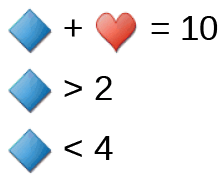
Find value of  (a) 5
(a) 5
(b) 6
(c) 7
(d) 8
 View Answer
View Answer 
Ans: (c)
Second relationship states that the value of a diamond is greater than 2, therefore possible values are, .... and so on.
.... and so on.
Third relationship states that the value of a diamond is less than 4, therefore among above
given values only possible value is, First relationship states that sum of the values of a diamond and a heart is 10. Therefore, if
First relationship states that sum of the values of a diamond and a heart is 10. Therefore, if
we subtract the value of the diamond from 10, we get the value of the heart.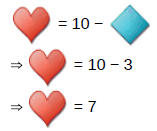
Q8: Find the missing number. (a) 32
(a) 32
(b) 8
(c) 16
(d) 4
 View Answer
View Answer 
Ans: (b)
Q9: In a line of boys , Naman is 11th from the top and Soham is 5th from the bottom . If Naman is 5 students ahead of Soham , then how many students are there in the line ?
(a) 18
(b) 21
(c) 20
(d) None of these
 View Answer
View Answer 
Ans: (b)
Naman is 11th from the top, so there are 10 students above him. Soham is 5th from the bottom, meaning there are 4 students below him. Since Naman is 5 students ahead of Soham, the total number of students is 10 + 4 + 1 + 5 = 21.
Q10: Which of the given options will complete the given pattern?
(a) 15L
(b) 18L
(c) 18M
(d) 15M
 View Answer
View Answer 
Ans: (c)
The pattern alternates between adding 5 to the first number and increasing the letter by 3 positions. After 13J, adding 5 gives 18, and J + 3 is M. Thus, the missing term is 18M.
Science
Q11: Vegetables cannot be preserved by _________.
(a) Drying
(b) Boiling
(c) Freezing
(d) Canning
 View Answer
View Answer 
Ans: (b)
- Vegetables can be preserved using various methods, but boiling is not one of them.
- Drying, freezing, and canning are effective techniques for preserving vegetables.
- Boiling typically cooks the vegetables, which can lead to spoilage rather than preservation.
- Therefore, the correct answer is that vegetables cannot be preserved by boiling.
Q12: Which organ help us to keep our body balance?
(a) 
(b) 
(c) 
(d) 
 View Answer
View Answer 
Ans: (a)
Ears help us to keep our body balance.
Q13: Normal value of decibel that our ears can detect is:
(a) – 20
(b) 0
(c) 20
(d) 40
 View Answer
View Answer 
Ans: (b)
The human ear can hear from 0 dB (threshold) to 120-130 dB.
Q14: Manisha investigated the properties of matter X. She noted down the following observations in her notebook.
- It has mass.
- It occupies space.
- It can be compressed.
- It takes the shape of the container that holds it.
Identify X.
(a) Air
(b) Honey
(c) Pebble
(d) Milk
 View Answer
View Answer 
Ans: (a)
X is air as it has mass, it occupies space, it can be compressed and takes the shape of the container that holds it.
Q15: Sam’s leg got injured while playing. Which of the following fruit will heal his wound?
(a) Banana
(b) Apple
(c) Orange
(d) All of these
 View Answer
View Answer 
Ans: (c)
Orange consists of vitamin C which helps his wound to heal.
Q16: Which of the following is the nearest, hottest as well as smallest planet of our solar system?
(a) Venus
(b) Jupiter
(c) Mercury
(d) Earth
 View Answer
View Answer 
Ans: (c)
Mercury is the nearest planet to the sun and hence, it is the hottest. It is also the smallest planet.
Q17: Most of the movements of the body are mediated by muscles and joint actions. The movement that does not involve muscle and joint action is:
(a) Kneeling down
(b) Bending of finger
(c) Blinking of eye
(d) None of the above
 View Answer
View Answer 
Ans: (c)
Blinking of eyes does not involve muscle and joint action.
Q18: Harsh categorized plants according to how their seeds are spread. He accidentally included an incorrect member in one of the groups. Choose the option that accurately identifies this group.
(a) Lotus, Coconut, Xanthium
(b) Maple, Hiptage, Dandelion
(c) Urena, Litchi, Watermelon
(d) Pea, Geranium, Balsam
 View Answer
View Answer 
Ans: (a)
- Lotus, Coconut, and Xanthium are all examples of plants that have seeds dispersed by water or wind.
- Pea, Geranium, and Balsam have different seed dispersal methods, making option (d) incorrect.
- Urena and Watermelon do not fit well with Litchi, which is not typically dispersed in the same way, indicating option (c) is incorrect.
- Maple, Hiptage, and Dandelion are also wind-dispersed, making option (b) correct.
Q19: Study the given relationship: Conglomerate : Quartzite : Obsidian. Select the option which correctly satisfies the same relationship.
(a) Limestone : Gneiss : Pumice
(b) Basalt : Granite : Slate
(c) Marble : Shale : Granite
(d) Shale : Basalt : Pumice
 View Answer
View Answer 
Ans: (a)
- The relationship involves types of rocks. Conglomerate, Quartzite, and Obsidian are all types of rocks.
- In option (a), Limestone, Gneiss, and Pumice also represent different types of rocks, maintaining the same classification.
- Other options do not follow the same pattern of rock types as clearly as option (a).
- Thus, option (a) is the correct choice as it satisfies the relationship of rock types.
Q20: Which of the following is a characteristic of a desert?
(a) Flowers bloom for eight weeks a year.
(b) It is home to rhinos and zebras.
(c) It has four seasons.
(d) It is very hot and very dry.
 View Answer
View Answer 
Ans: (d)
Desert ecosystems are located in regions that receive very less rainfall. Due to the extremely high temperature, low water availability and intense sunlight, fauna and flora are scarce and poorly developed.
Q21: Why is the animal shown in the figure considered a mammal although it lays eggs which hatch into live young ones?
 1. It is able to dive underwater.
1. It is able to dive underwater.
2. It has fur covering its body.
3. It has webbed feet.
4. It breathes through its lungs.
Select the correct option:
(a) 4 only
(b) 1, 2 and 3
(c) 2 and 4
(d) 1, 2, 3 and 4
 View Answer
View Answer 
Ans: (a)
The given animal is considered a mammal because it breathes through its lungs
Q22: Which of the following methods would help to control the number of mosquitoes?
I. By taking medicines which prevent malaria.
II. By putting oil on the surface of water in a big pool.
III. By keeping the surrounding dry and clean.
IV. By spraying chemicals.
Select the correct option:
(a) Only I
(b) Only II and III
(c) Only I, II and III
(d) Only II, III and IV
 View Answer
View Answer 
Ans: (d)
Mosquitoes breed in stagnant water, so we should keep the surroundings dry and spray oil or chemicals on stagnant water that kills the larva and prevent malaria.
Q23: Which one of the following gases is highly concentrated in the air?
(a) Oxygen
(b) Carbon dioxide
(c) Nitrogen
(d) Methane
 View Answer
View Answer 
Ans: (c)
The concentration of nitrogen in the air is about 78 %. Therefore, option (c) is correct and rest of the options is incorrect.
Q24: Select the odd one out based on the season in which a crop is cultivated.
(a) Jowar
(b) Bajra
(c) Linseed
(d) Corn
 View Answer
View Answer 
Ans: (c)
- Linseed is typically grown in the rabi season, which is different from the other options.
- Jowar, Bajra, and Corn are usually cultivated in the kharif season.
- This makes Linseed the odd one out as it does not share the same growing season as the others.
- Understanding the growing seasons of crops is essential for agriculture and farming practices.
Q25: Why can‘t we make statue of water?
A: Liquid can‘t have its own shape.
B: It is hard to change shape of water like iron.
(a) Only A
(b) Only B
(c) Both A and B
(d) Neither A nor B
 View Answer
View Answer 
Ans: (a)
We can’t make statue of water because liquid can’t have it own shape.
Q26: Shred a paper into tiny pieces. Take a comb and comb your hair. Now bring the comb closer to the paper pieces. What will you observe?
(a) The paper pieces will get repelled due to magnetic force.
(b) The paper pieces will get repelled due to electrostatic force.
(c) The paper pieces will get attracted and stick to the comb due to electrostatic force.
(d) The paper pieces will get attracted and stick to the comb due to frictional force.
 View Answer
View Answer 
Ans: (c)
Electrostatic force of attraction acts between two opposite charges.
Q27: Reena placed an object X in between a reflecting surface and a screen Q, on which an image of X was formed. If a clear image of object X is formed on the screen Q, then which of the following properties is correct for object X?
(a) Transparent
(b) Translucent
(c) Opaque
(d) All the above
 View Answer
View Answer 
Ans: (c)
Shadows can be formed only in the presence of a source of light. Light always casts shadows of the opaque objects placed in its path.
Q28: On the basis of the type of nutrient the food provides, select the option in which the odd one is encircled incorrectly.
(a) Fish, Pulses, (Ghee)
(b) (Vegetable oil), Cheese, Milk
(c) Bread, (Roti), Butter
(d) (Muskmelon), Potato, Sugar
 View Answer
View Answer 
Ans: (c)
- The question asks to identify the option where the odd one out is incorrectly marked. In option (c), Bread and Roti are both carbohydrates, while Butter is a fat. This makes Butter the odd one out.
- In contrast, the other options group foods that provide similar types of nutrients, such as proteins or fats.
- Thus, option (c) is the correct answer as it contains a food item that does not match the others in terms of nutrient type.
Q29: Which of the following is utilized to safeguard garments from insects?
(a) Neem leaves
(b) Lotus leaves
(c) Papaya leaves
(d) Banyan leaves
 View Answer
View Answer 
Ans: (a)
- Neem leaves are known for their insect-repelling properties, making them effective in protecting clothes from pests.
- They contain natural compounds that deter insects, which is why they are often used in traditional methods for safeguarding textiles.
- Other options like lotus leaves, papaya leaves, and banyan leaves do not have the same level of effectiveness against insects.
- Using neem leaves is a common practice in many cultures for keeping clothes safe from damage caused by insects.
Q30: Read the conversation between Lalita and Sahil: Lalita: On the Moon, it is freezing cold at night. Sahil: The Moon is a silent place as sound does not travel there. Select the correct option regarding the conversation.
(a) Both Lalita and Sahil have made correct statements.
(b) Both Lalita and Sahil have made incorrect statements.
(c) Lalita has made a correct statement, while Sahil has made an incorrect statement.
(d) Lalita has made an incorrect statement, while Sahil has made a correct statement.
 View Answer
View Answer 
Ans: (a)
- Both statements are accurate: Lalita is correct that it gets extremely cold on the Moon at night, as there is no atmosphere to retain heat.
- Sahil's statement is also true: Sound cannot travel on the Moon because it requires a medium (like air) to propagate, and the Moon has no atmosphere.
- Thus, both Lalita and Sahil have provided correct information about the conditions on the Moon.
Q31: Identify X, Y and Z in the given figure.
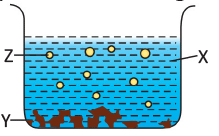
(a) X-gas, Y-solid, Z-liquid
(b) X-liquid, Y-solid, Z-gas
(c) X-gas, Y-liquid, Z-solid
(d) X-solid, Y-liquid, Z-gas
 View Answer
View Answer 
Ans: (b)
In the given figure, X is liquid, Y is solid and Z is gas.
Q32: Which of the following scenarios demonstrates the benefit of friction?
(a) Pushing a heavy box across the room
(b) Sailing across a river in rough weather
(c) Running towards a shelter in heavy rain
(d) Driving a car on a smooth road
 View Answer
View Answer 
Ans: (c)
- Friction is a force that opposes motion, but it can be beneficial in certain situations.
- In this case, running towards a shelter in heavy rain is advantageous because friction between your shoes and the ground helps you maintain your balance and speed.
- Without sufficient friction, you could easily slip and fall, making it harder to reach safety.
- Thus, friction plays a crucial role in helping us move effectively in slippery conditions.
Q33: Which of the following statements are accurate?
(a) 1 and 4 only
(b) 2 and 3 only
(c) 1, 3 and 4 only
(d) 1, 2, 3 and 4
 View Answer
View Answer 
Ans: (c)
- A change in state of a substance changes the interparticle distances. - This is true because when a substance changes state (like from solid to liquid), the distance between particles changes.
- A change in state of a substance changes its composition. - This is false; the composition remains the same, only the state changes.
- A change in state of a substance changes its shape. - This is true; for example, ice (solid) takes a different shape than water (liquid).
- A change in state of a substance changes intermolecular forces. - This is also true; the forces between particles change when a substance changes state.
Correct answer is (c) 1, 3 and 4 only.
The correct statements are 1, 3, and 4, as they accurately describe how a change in state affects interparticle distances, shape, and intermolecular forces, while the composition remains unchanged.
Q34: Which of the following is an incorrect match of the everyday objects and the simple machine involved in its functioning?
(a) Elevator-Pulley
(b) Escalator-Wedge
(c) Pepper mill-Wheel and axle
(d) Ladder-Inclined plane
 View Answer
View Answer 
Ans: (b)
An escalator is an example of inclined plane.
Q35: Which of the following statements is correct regarding food?
(a) Roughage present in vegetables and fruits must be discarded.
(b) Overcooking decreases the nutritive value of food.
(c) Canned food has more nutritive value than fresh food.
(d) Growing children need more fats to build strong muscles.
 View Answer
View Answer 
Ans: (b)
- Overcooking food can lead to a loss of essential vitamins and minerals, making it less nutritious.
- Roughage, or fiber, is important for digestion and should not be discarded.
- Fresh food generally retains more nutrients compared to preserved or canned food.
- While children do need fats, they also require a balanced diet with proteins, carbohydrates, and vitamins for overall growth.
Q36: Some animals move in groups from one place to another in search of food or suitable environments during unfavorable conditions. This mass movement of animals is called __________.
(a) Suspension
(b) Hibernation
(c) Migration
(d) Displacement
 View Answer
View Answer 
Ans: (c)
- Migration refers to the seasonal movement of animals from one region to another, often in search of better food sources or more favorable living conditions.
- During unfavorable conditions, such as harsh weather or food scarcity, many animals travel together in groups.
- This behavior helps them survive by finding suitable environments where resources are more abundant.
- Other options like suspension, hibernation, and displacement do not accurately describe this specific movement of animals.
Q37: Select the correct pairing.
(a) Locust - Migratory mammal
(b) Arctic tern - Migratory bird
(c) Eel - Migratory insect
(d) Humpback whale - Migratory fish
 View Answer
View Answer 
Ans: (b)
- Arctic tern is known for its long migrations, making it a true migratory bird.
- The other options incorrectly classify animals; for example, locusts are insects, not mammals.
- Understanding animal classifications helps in recognizing their migration patterns.
- Thus, the correct match is the Arctic tern as a migratory bird.
Q38: Match the following :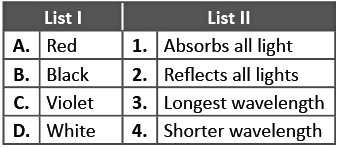
(a) A-3, B-1, C-4, D-2
(b) A-1, B-3, C-2, D-4
(c) A-2, B-3, C-1, D-4
(d) A-4, B-1, C-2, D-3
 View Answer
View Answer 
Ans: (a)
Red has longest wavelength, black absorbs all light, violet has shorter wavelength while white reflects all lights.
Q39: The given picture is showing:
 (a) Solar eclipse
(a) Solar eclipse
(b) Lunar eclipse
(c) Star eclipse
(d) Both (a) and (b)
 View Answer
View Answer 
Ans: (a)
When the moon comes between the earth and the sun, it blocks the sunlight to an extent. This is solar eclipse as the sun is eclipsed or hidden partially from the view.
Q40: Select the incorrect pairing from the options below:
(a) Chalk - Limestone
(b) The Red Fort - Sandstone
(c) Silver - Metallic mineral
(d) Petroleum - Non-metallic mineral
(e) Granite - Metamorphic rock
 View Answer
View Answer 
Ans: (b)
- Chalk is indeed a form of Limestone, so that pairing is correct.
- The Red Fort is primarily made of Sandstone, which is also accurate.
- Silver is classified as a Metallic mineral, making that pairing correct.
- Petroleum is considered a Non-metallic mineral, which is also true.
- However, Granite is not a Metamorphic rock; it is an Igneous rock, making option (b) the incorrect match.
Q41: Which of the following statements is false regarding soil pollution?
(a) It is caused when farmers use too much of pesticides.
(b) It is caused when people throw away old plastic bottles on land.
(c) It is caused when hospital wastes are disposed of in open grounds.
(d) It increases when the use of fertilizers decreases.
 View Answer
View Answer 
Ans: (d)
- Soil pollution refers to the contamination of soil with harmful substances.
- Option (a) is true because excessive use of pesticides can lead to soil contamination.
- Option (b) is also true as plastic waste can accumulate and pollute the land.
- Option (c) is correct since improper disposal of hospital waste can harm the soil.
- However, option (d) is incorrect because soil pollution actually increases with the use of harmful substances, not when fertilizers are reduced.
Q42: Mona met with an accident, after which she has lost her speech and memory. Which part of her brain was affected?
(a) Medulla
(b) Cerebrum
(c) Cerebellum
(d) Nerves
 View Answer
View Answer 
Ans: (b)
Cerebrum is responsible for learning, speech and memory.
Q43: Priya enjoys sky watching in night. She saw a full moon in sky on 15th August. After 15 days she realized that it was the new moon. What would be shape of the moon on 15 September?
(a)  (b)
(b)  (c)
(c)  (d)
(d) 
 View Answer
View Answer 
Ans: (c)
Q44: Complete the missing link of the following marine food chain.
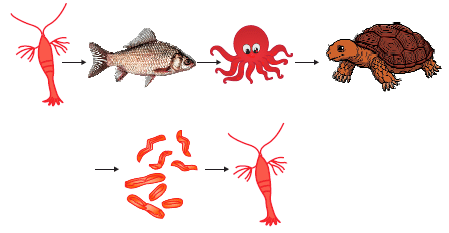
(a) Shark
(b) Elephant
(c) Snail
(d) Shrimp
 View Answer
View Answer 
Ans: (a)
Shark is decomposed by bacteria.
Q45: The given diagram depicts .................. processes of the change of state of matter.
 (a) Sublimation
(a) Sublimation
(b) Evaporation
(c) Vaporization
(d) Condensation
 View Answer
View Answer 
Ans: (d)
As seen in the diagram, there are small water drops on the leaf. These water drops can be seen as a result of the conversion of water vapour in the air back into the water form. Thus this depicts the process of condensation.
Achievers Section
Q46: Meetu has four sheets made of different materials. She arranges the sheets R, S, T, and U in a straight line. When the torch is switched on, a bright circular patch of light is seen on sheet S only. Which of the following conclusions can be made from this? (a) Sheet R is made of an opaque material.
(a) Sheet R is made of an opaque material.
(b) Sheet S is made of a transparent material.
(c) Sheet T is made of a translucent material.
(d) Sheet U is made of an opaque material.
 View Answer
View Answer 
Ans: (d)
Sheet U is made of an opaque material.
Q47: X changes to Y on condensation. Select the option that correctly represents the arrangement of molecules in X and Y.
(a)  (b)
(b)  (c)
(c)  (d)
(d) 
 View Answer
View Answer 
Ans: (b)
Q48: Refer to the given statements and select the option that correctly identifies the incorrect ones:
(i) Odissi is a folk dance form of Odisha.
(ii) Ajanta Caves in Madhya Pradesh have paintings made by Buddhist monks.
(iii) The Gateway of India is a 26m high structure present at Apollo Bunder in Mumbai.
(iv) Around the base of the Sun Temple of Konark there are images of animals, foliage, warriors on horses, etc.
(v) Qutub Minar is surrounded by structures like Alai Darwaza, Tomb of Iltutmish, etc. .
A. (i) and (ii) only
B. (iii), (iv) and (v) only
C. (i), (ii) and (iii) only
D. (ii), (iv) and (v) only
 View Answer
View Answer 
Ans: (a)
- Statement (i) is incorrect because Odissi is a classical dance form, not a folk dance.
- Statement (ii) is correct as the Ajanta Caves indeed feature paintings by Buddhist monks.
- Statement (iii) is correct; the Gateway of India is approximately 26 meters high.
- Statement (iv) is correct; the Sun Temple of Konark has various intricate carvings.
- Statement (v) is correct; Qutub Minar is surrounded by historical structures.
Q49: Solve the given puzzle based on diseases and select the option that is not hidden in this puzzle.
(a) A disease that can spread by biotic agent.
(b) A disease that spreads by contaminated food or water.
(c) A disease that is caused due to the deficiency for energy-giving food.
(d) A disease that is caused due to the deficiency of protective food.
 View Answer
View Answer 
Ans: (a)
A disease that can spread by biotic agent is malaria.
Q50: Identify food items 2, 3, 4 and 5 in the given food pyramid and select the correct option.
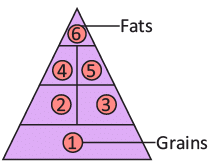
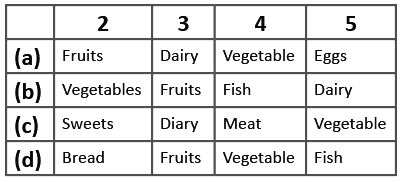
 View Answer
View Answer 
Ans: (b)
2- is vegetables, 3- Fruits, 4- Fish, 5- Dairy
|
37 videos|80 docs|50 tests
|
FAQs on Science Olympiad Model Test Papers - 3 - Science Olympiad for Class 5
| 1. What topics are typically covered in Class 5 Science Olympiad model test papers? |  |
| 2. How can I prepare effectively for the Class 5 Science Olympiad? |  |
| 3. Are the questions in the Science Olympiad multiple-choice or descriptive? |  |
| 4. How important is it to participate in the Science Olympiad for Class 5 students? |  |
| 5. What resources can I use to find additional practice questions for the Science Olympiad? |  |





















